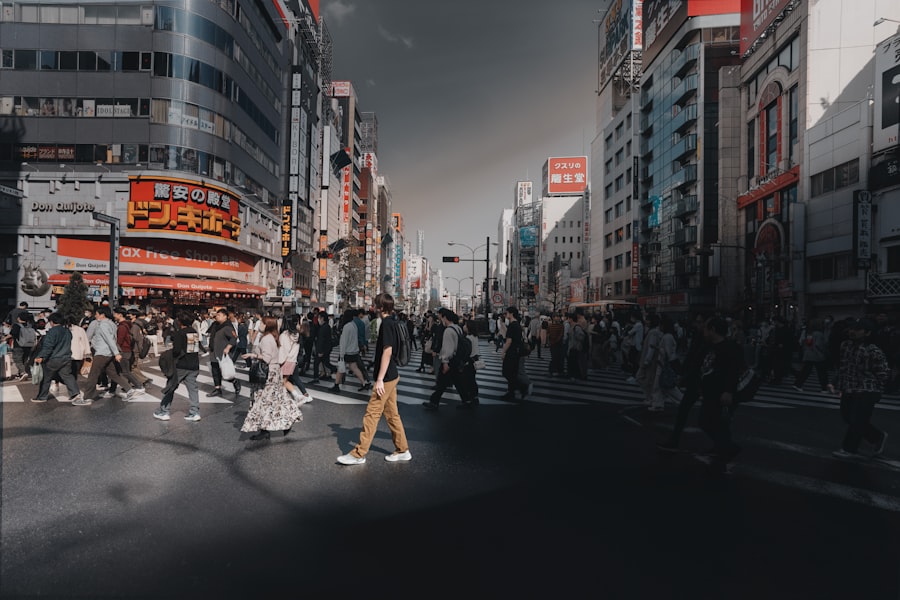Kaiju, a term that translates to “strange beast” in Japanese, refers to a genre of films and media featuring gigantic monsters that often wreak havoc on cities and engage in epic battles. These colossal creatures have captured the imagination of audiences worldwide, becoming cultural icons that transcend borders. The fascination with kaiju stems from their embodiment of humanity’s fears and aspirations, representing both destruction and resilience.
As you delve into the world of kaiju, you will discover a rich tapestry of stories that explore the relationship between humans and these titanic beings, revealing deeper themes about nature, technology, and the human condition. The origins of kaiju can be traced back to early 20th-century cinema, with films like “King Kong” paving the way for the genre. However, it was Japan’s Toho Studios that truly popularized kaiju with the release of “Godzilla” in 1954.
This film not only introduced audiences to a terrifying creature but also served as a poignant commentary on the consequences of nuclear warfare. As you explore the evolution of kaiju in both American and Japanese comics, you will see how these monstrous figures have been reinterpreted and adapted to reflect societal concerns, cultural values, and artistic expressions unique to each region.
Key Takeaways
- Kaiju are giant monsters from Japanese folklore and have become popular in American and Japanese comics.
- American comics often portray Kaiju as destructive forces, while Japanese comics often depict them as protectors or symbols of nature.
- Cultural differences influence the portrayal of Kaiju in comics, with American comics focusing on action and destruction, and Japanese comics emphasizing themes of harmony and balance.
- Themes and motifs in American Kaiju comics often revolve around the consequences of human actions and the struggle for survival.
- Themes and motifs in Japanese Kaiju comics often explore the connection between humanity and nature, and the consequences of environmental destruction.
Kaiju in American Comics
In American comics, kaiju have made their mark primarily through the lens of superhero narratives and science fiction. Characters like Godzilla have crossed over into the comic book realm, often depicted as both a threat and an anti-hero. The American interpretation of kaiju tends to emphasize action-packed battles and larger-than-life confrontations, appealing to readers who crave excitement and spectacle.
You may find that these stories often revolve around the struggle between humanity and these monstrous beings, showcasing the resilience of the human spirit in the face of overwhelming odds. Moreover, American comics frequently incorporate elements of humor and satire when portraying kaiju. Titles like “Kaijumax” blend monster mayhem with social commentary, exploring themes such as incarceration and redemption through the lens of kaiju characters.
This unique approach allows for a more nuanced exploration of the genre, inviting readers to reflect on broader societal issues while enjoying the thrilling escapades of their favorite monsters. As you navigate through these narratives, you’ll notice how American comics have embraced kaiju as a versatile storytelling device, capable of addressing both lighthearted and serious themes.
Kaiju in Japanese Comics

Japanese comics, or manga, have a long-standing tradition of featuring kaiju that is deeply rooted in cultural mythology and folklore. In contrast to their American counterparts, Japanese kaiju stories often delve into existential themes and moral dilemmas. Manga series like “Attack on Titan” and “Godzilla: The Half-Century War” explore the complexities of human nature when faced with overwhelming threats.
You will find that these narratives frequently challenge the notion of good versus evil, presenting kaiju as multifaceted beings that evoke both fear and empathy. Additionally, Japanese comics often emphasize the emotional and psychological impact of kaiju encounters on characters. The struggles faced by protagonists in these stories are not merely physical; they grapple with loss, trauma, and the consequences of their actions.
This depth adds layers to the kaiju genre, allowing readers to connect with characters on a more personal level. As you immerse yourself in these manga tales, you’ll discover how Japanese creators use kaiju to explore themes of identity, sacrifice, and the fragility of human existence.
Cultural Differences in Kaiju Portrayal
| Aspect | Japanese Kaiju Portrayal | Western Kaiju Portrayal |
|---|---|---|
| Physical Appearance | Often reptilian or dinosaur-like with traditional Japanese monster features | Varies widely, often more fantastical and less grounded in traditional monster imagery |
| Behavior | May have a more mystical or spiritual significance, often tied to natural disasters | Often portrayed as a result of human experimentation or nuclear radiation |
| Role in Story | May serve as a metaphor for societal issues or represent the consequences of human actions | Often seen as a force of destruction to be defeated by human technology or military |
The portrayal of kaiju varies significantly between American and Japanese comics, reflecting broader cultural differences in storytelling traditions. In American narratives, kaiju are often depicted as external threats that must be vanquished for humanity to survive. This perspective aligns with a more individualistic culture that values heroism and triumph over adversity.
You may notice that American stories frequently focus on the action and spectacle of battles between humans and monsters, emphasizing physical strength and technological prowess. Conversely, Japanese portrayals of kaiju tend to emphasize interconnectedness and the consequences of human actions on nature. In many Japanese stories, kaiju are not merely antagonists but are often seen as manifestations of humanity’s own failings—be it environmental destruction or moral decay.
This perspective invites readers to reflect on their relationship with nature and the responsibilities that come with technological advancement. As you explore these cultural nuances, you’ll gain a deeper understanding of how societal values shape the narratives surrounding kaiju in both regions.
Themes and Motifs in American Kaiju Comics
American kaiju comics often revolve around themes of heroism, sacrifice, and the struggle for survival. The protagonists are typically portrayed as brave individuals or teams who must confront these monstrous threats head-on. You may find that stories frequently highlight the importance of unity and collaboration in overcoming seemingly insurmountable challenges.
This emphasis on teamwork resonates with readers who appreciate narratives that celebrate collective strength in the face of adversity. Another prevalent motif in American kaiju comics is the exploration of technology’s role in combating these colossal creatures. From advanced weaponry to giant robots like Mechagodzilla, technology is often depicted as humanity’s primary means of defense against kaiju attacks.
This theme reflects a cultural fascination with innovation and progress while also raising questions about the ethical implications of such advancements. As you engage with these narratives, you’ll see how American creators use kaiju to comment on contemporary issues related to science, technology, and environmental concerns.
Themes and Motifs in Japanese Kaiju Comics

In contrast to their American counterparts, Japanese kaiju comics delve into themes of existentialism, environmentalism, and the consequences of human actions. The narratives often explore how humanity’s hubris leads to catastrophic encounters with these monstrous beings. You may find that stories like “Godzilla: The Planet Eater” highlight the destructive potential of unchecked technological advancement while urging readers to consider their responsibility toward nature.
Additionally, Japanese kaiju comics frequently incorporate elements of folklore and mythology, enriching their narratives with cultural significance. The portrayal of kaiju as ancient beings or guardians of nature adds depth to their characterization, inviting readers to reflect on humanity’s place within the natural world. As you immerse yourself in these stories, you’ll discover how Japanese creators use kaiju to convey messages about harmony with nature and the importance of respecting the environment.
Influence of Kaiju on Popular Culture
The influence of kaiju extends far beyond comics and films; it has permeated various aspects of popular culture worldwide. From video games to merchandise, these colossal creatures have become symbols of entertainment that resonate with audiences across generations. You may notice how franchises like “Godzilla” have inspired countless adaptations, parodies, and homages in different media forms, showcasing their enduring appeal.
Moreover, kaiju have sparked a resurgence in interest in giant monster films and media globally. The success of recent blockbusters like “Pacific Rim” and “Kong: Skull Island” has reignited fascination with giant creatures battling for supremacy. This renewed interest has led to collaborations between American and Japanese creators, resulting in cross-cultural projects that celebrate the legacy of kaiju while introducing new audiences to their rich history.
As you explore this influence on popular culture, you’ll see how kaiju continue to evolve while remaining relevant in contemporary storytelling.
Future of Kaiju in American and Japanese Comics
As you look toward the future of kaiju in both American and Japanese comics, it becomes clear that these monstrous figures will continue to adapt and evolve alongside societal changes. In America, there is potential for more diverse representations within the genre as creators from various backgrounds bring fresh perspectives to kaiju narratives. This could lead to stories that challenge traditional tropes while exploring new themes related to identity, culture, and environmentalism.
In Japan, the enduring legacy of kaiju will likely inspire new generations of creators who seek to reinterpret these iconic monsters for modern audiences. As environmental concerns grow more pressing globally, it is possible that future manga will delve deeper into ecological themes while maintaining the emotional depth characteristic of Japanese storytelling. You may find that both American and Japanese comics will continue to push boundaries, exploring innovative ways to engage with kaiju while reflecting contemporary issues.
In conclusion, the world of kaiju is a dynamic landscape filled with rich narratives that resonate across cultures. Whether through action-packed battles or introspective explorations of humanity’s relationship with nature, these colossal creatures offer a unique lens through which we can examine our fears, aspirations, and responsibilities. As you continue your journey through this fascinating genre, you’ll uncover layers of meaning that speak not only to our fascination with monsters but also to our shared human experience.
